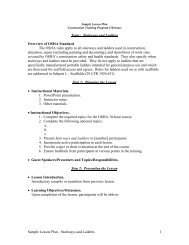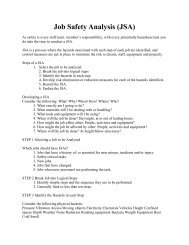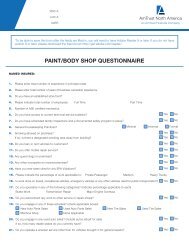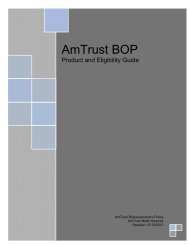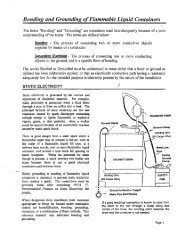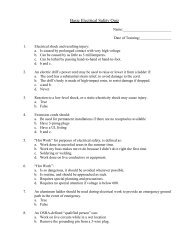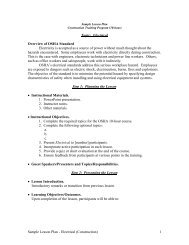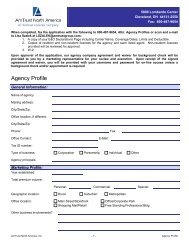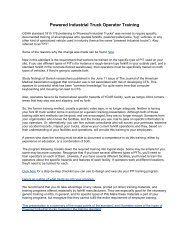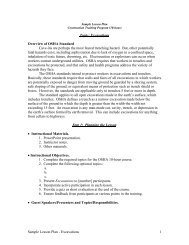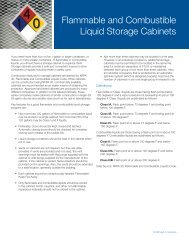Poison Ivy, Oak, and Sumac Fact Sheet - AmTrust North America
Poison Ivy, Oak, and Sumac Fact Sheet - AmTrust North America
Poison Ivy, Oak, and Sumac Fact Sheet - AmTrust North America
- No tags were found...
You also want an ePaper? Increase the reach of your titles
YUMPU automatically turns print PDFs into web optimized ePapers that Google loves.
<strong>Poison</strong> <strong>Ivy</strong>, <strong>Oak</strong>,<strong>and</strong> <strong>Sumac</strong> <strong>Fact</strong> <strong>Sheet</strong>HS04-0641(11-04)Employers <strong>and</strong> employees should take precautionswhen working in <strong>and</strong> around wooded areas <strong>and</strong> in heavyfoliage, because they may come in contact with poisonivy, oak or sumac. Approximately 90 percent of <strong>America</strong>nsare allergic to these plants that cause a bothersomerash <strong>and</strong> intense itching.Touching the stems, roots, or leaves of these plantsresults in direct contact ofskin with urushiol (pronouncedoo-roo-shee-ohl)oil, which causes the itching.The cause of the rash,blisters, <strong>and</strong> infamous itchis from the exposure tourushiol, a chemical in thesap of poison ivy, oak <strong>and</strong>sumac plants. Because urushiolis inside the plant, brushing against an intact plantwill not cause a reaction. But undamaged plants are rare.Urushiol can stick to tools, shoes, clothes, or anything.Just touching them could cause a reaction in a susceptibleperson.Sensitivity to urushiol can develop at any time. Almostall parts of the body are vulnerable to the sticky urushiol.Urushiol must penetrate the skin to cause a reaction.Places where the skin is thick, such as the soles of the feet<strong>and</strong> the palms of the h<strong>and</strong>s, are less sensitive to the sapthan areas where the skin is thinner.Urushiol Oil is PotentUrushiol oil is potent <strong>and</strong> it only takes a small amountto cause an allergic reaction.• Only 1 nanogram (billionth of agram) is needed to cause a rash.• The average person is exposed to100 nanograms per exposure.• 1/4 ounce of urushiol is all thatis needed to cause a rash in everyperson on earth.<strong>Poison</strong> <strong>Ivy</strong>• 500 people could itch from theamount covering the head of a pin.• Specimens of urushiol severalcenturies old have been found tocause dermatitis in sensitive people.• 1 to 5 years is normal for urushioloil to stay active on any surfaceincluding dead plants.• The name urushiol is derived fromurushi, Japanese name for lacquer.Myth<strong>Poison</strong> <strong>Ivy</strong> rash iscontagious.You can catchpoison ivy simplyby being near theplants.Leaves of three,let them be.Do not worryabout dead plants.Breaking theblisters releasesurushiol oil thatcan spread.I’ve been inpoison ivy manytimes <strong>and</strong> neverbroken out. I’mimmune.<strong>Fact</strong>Rubbing the rash won’t spreadpoison ivy to other parts of yourbody (or to another person). Youspread the rash only if urushioloil - the sticky, resin likesubstance that causes the rash -has been left on your h<strong>and</strong>s.Direct contact with the plantsis needed to release urushioloil. Stay away from forest fires,direct burning, <strong>and</strong> lawnmowers<strong>and</strong> trimmers when they arebeing used because they cancause the urushiol oil to becomeairborne.<strong>Poison</strong> sumac has 7 to 13 leaveson a branch, although poisonivy <strong>and</strong> oak have 3 leaves percluster.Urushiol oil stays active on anysurface, including dead plants,for up to 5 years.Not true. However wounds canbecome infected <strong>and</strong> make thescarring worse. In very extremecases, excessive fluid may needto be withdrawn by a doctor.Not necessarily true. The moretimes a person is exposed tourushiol, the more likely theywill break out with an allergicreaction. For the first timesufferer, it generally takeslonger for the rash to show up -generally in 7 to 10 days.
Quick Action NeededBecause urushiol can penetrate the skin within minutes,do not waste time if exposed. The faster the victim’sskin is cleansed, the greater the chance of removing theurushiol before it gets attached to the skin. Cleansing maynot stop the initial outbreak of the rash if more than 10minutes has passed, but it can help prevent further spread.If exposed to poison ivy, oak or sumac, if possible, stayindoors until the following steps are completed:1. Cleanse exposed skin with generousamounts of isopropyl (rubbing)alcohol. (Don’t return to the woodsor yard the same day. Alcoholremoves your skin’s protectionalong with the urushiol <strong>and</strong> any newcontact will cause the urushiol topenetrate twice as fast.)2. Wash exposed skin with water.(Water temperature does not matter;if you’re outside, its likely only coldwater will be available.)3. Take a shower with soap <strong>and</strong> warmwater. Do not use soap before thispoint because soap tends to pickup some of the urushiol from thesurface of the skin <strong>and</strong> move itaround.4. Clothes, shoes, tools, <strong>and</strong> anythingelse that may have been in contactwith the urushiol should be wipedoff with alcohol <strong>and</strong> water.Wear gloves or cover h<strong>and</strong>s while completing the steps<strong>and</strong> then discard the h<strong>and</strong> covering.Dealing with the RashIf the victim doesn’t cleanse quickly enough, or theskin is so sensitive that cleansing didn’t help, redness<strong>and</strong> swelling may appear in about 12 to 48 hours. Blisters<strong>and</strong> itching will follow. For those rare people who reactafter their very first exposure, the rash appears after 7 to10 days. Because they don’t contain urushiol, the oozingblisters are not contagious nor can the fluid cause furtherspread on the affected person’s body. Nevertheless,scratching the blisters with the fingernails that may carrygerms could cause an infection.The rash will only occur where urushiol has touchedthe skin; it doesn’t spread throughout the body. However,the rash may seem to spread if it appears over time insteadof all at once. This is either because the urushiol is absorbedat different rates in different parts of the body orbecause of repeated exposure to contaminated objects orurushiol trapped under the fingernails.The rash, blisters <strong>and</strong>itch normally disappearin 14 to 20 days withoutany treatment. But few canh<strong>and</strong>le the itch withoutsome relief. For mild cases,wet compresses, or soakingin cool water may be effective.Oral antihistaminescan also relieve itching.The U.S. Food <strong>and</strong> DrugAdministration (FDA) alsoconsiders over-the-countertopical corticosteroids(commonly called hydrocortisones) are normally safe <strong>and</strong>effective for temporary relief of itching associated withpoison ivy.For severe cases, prescription topical corticosteroiddrugs can halt the reaction, but only if treatment beginswithin a few hours of exposure. The <strong>America</strong>n Academyof Dermatology recommends that people who have hadsevere reactions in the past should contact a dermatologistas soon as possible after a new exposure.There are a number of over the counter products tohelp dry up oozing blisters, including:• aluminum acetate (Burrows solution);• baking soda;• Aveeno (oatmeal bath);• aluminum hydroxide gel;• calamine;• kaolin;• zinc acetate;• zinc carbonate; <strong>and</strong><strong>Poison</strong> <strong>Oak</strong>• zinc oxide.Desensitization, vaccines, <strong>and</strong> barrier creams havebeen studied over the last several decades for their potentialto protect against poison ivy reactions, but none havebeen approved by the FDA for this purpose.For the Rash:Hydrocortisone creams or sprays reduce the inflammation,swelling, <strong>and</strong> itching of poison ivy rashes. Theyshould be used four times a day for best effect. Lotions
containing calamine, zinc acetate, <strong>and</strong> alcohol dry theblistered rash quickly <strong>and</strong> can speed healing.A rash can last 1-4 weeks. Treatment is directed at theintense itching, <strong>and</strong> shrinking the rash. Treating the itchingis especially important, since scratching can lead toskin infection.Antihistamines are available as topical (cream, lotion,or spray) or oral. The oral forms are probably more effective,but can cause drowsiness. Topical antihistamines areless effective <strong>and</strong> can cause a rash of their own in somepeople.Drying agents like calamine or other lotions are verysoothing <strong>and</strong> speed healing of the rash. Menthol, benzocaine,<strong>and</strong> pramoxine are topical anesthetics to “numb”the itchy rash. They work well, but they must be appliedoften. Cool soaks in baking soda, commercial oatmeal, orcolloidal baths for 15-30 minutes can relieve itching forseveral hours at a time.Signs of an EmergencyAbout 15 percent of the 120 million <strong>America</strong>ns whoare allergic to poison ivy, oak, <strong>and</strong> sumac are so highlysensitive to the plants that they break out in a rash <strong>and</strong>begin to swell in 4 to 12 hours instead of the normal 24 to48. Their eyes may swell shut <strong>and</strong> blisters may erupt ontheir skin. This is an emergency. Call EMS or 911 <strong>and</strong>get them to a hospital as soon as possible.Controlling <strong>Poison</strong> <strong>Ivy</strong>,<strong>Oak</strong> <strong>and</strong> <strong>Sumac</strong><strong>Poison</strong> ivy, oak, <strong>and</strong> sumac control, can be done at anytime of the year, but is best achieved May through Julywhile the plants are flowering. <strong>Poison</strong> ivy, oak, <strong>and</strong> sumacshould be accurately identified before attempting any controlmeasures. Spraying is recommended over burning becausepoison ivy oil vaporizes when hot, carries in smoke<strong>and</strong> can cause an allergic reaction <strong>and</strong> a severe rash.<strong>Poison</strong> ivy, oak, <strong>and</strong> sumacfoliage within reach canbe sprayed with glyphosate(sold under the trade namesRoundup, Kleenup <strong>and</strong> others)according to label directions.When using this or any herbicide,always read <strong>and</strong> followlabel directions carefully. Takecare to avoid other plants <strong>and</strong>do not spray so heavily that theherbicide drips off the leaves.Glyphosate is a nonselective <strong>Poison</strong> <strong>Sumac</strong>herbicide <strong>and</strong> will kill any vegetationit contacts.To kill poison ivy, oak, <strong>and</strong> sumac that climb high intotrees, cut the vine off 6 inches above ground level. Treatthe stump with glyphosate (according to label directions)immediately after cutting to kill the roots <strong>and</strong> preventsprouting. If resprouting does occur, treat the leaves withglyphosate.<strong>Poison</strong> ivy, oak, <strong>and</strong> sumac can be very persistent, sovines may have to be sprayed two or more times for completecontrol. <strong>Poison</strong> ivy, oak, <strong>and</strong> sumac can spread alongfence or hedge rows <strong>and</strong> under trees by birds dispersingthe seeds. Treating young seedlings with glyphosate willkill them <strong>and</strong> limit the spread of the plant(s).It is recommended that when working in wooden areas<strong>and</strong> in heavy foliage, that workers wear long pants, longsleeves, boots, <strong>and</strong> plastic under cotton gloves for protection.Remember to practice safety, don’t learn it by accident.This fact sheet was published with information fromthe U.S. Food <strong>and</strong> Drug Administration, the <strong>Poison</strong> <strong>Ivy</strong>Information Center, the Missouri Department of Conservation<strong>and</strong> the Texas Workers’ Compensation Commission.Texas Workers’ Compensation CommissionE-mail resource.center@twcc.state.tx.usor call (512) 804-4620 for more information.Safety Violations Hotline1-800-452-9595safetyhotline@twcc.state.tx.us



